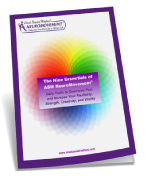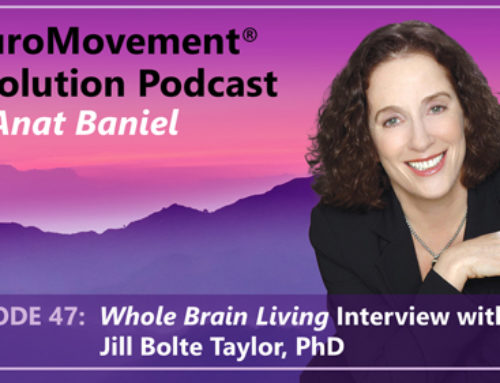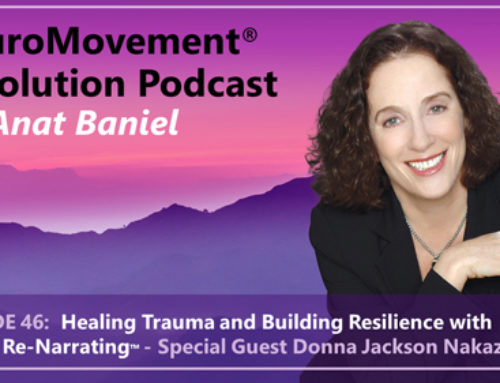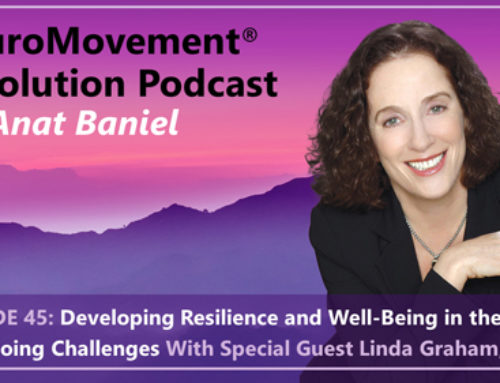Jill Bolte Taylor and Anat Baniel in Conversation
Setting Up the Brain for Success – Conversation 1
JBT: I am Jill Bolte Taylor, and I care about maximizing the brain and its relationship with our body so we can bring the best of ourselves into the world. Every ability we have, we have because we have cells that perform that function, and when I experienced the hemorrhage in the left half of my brain, I could not walk, talk, read, write, or recall any of my life. It took eight years for me to completely recover all cognitive and physical function.
I am in conversation with Anat Baniel because she applies the exact same principles when helping people overcome limitation that I used to recover my brain and body from stroke. Anat understands that for any meaningful change to happen in the way we think, move, and use our body, the change has to happen in the brain. By shifting the focus of rehabilitation from the muscles and bones to the brain, we unleash the staggering potential of the brain to heal itself.
AB: I am Anat Baniel, and I care about helping people make the seemingly impossible possible when it comes to the brain’s ability to manifest a powerful and vibrant life.
I was blessed to spend over a decade of my life first as a student and then as a colleague of Dr. Moshe Feldenkrais. He was a trained physicist who worked with Marie and Julio Curie, and he was a pioneer in the field of neuroplasticity long before the term existed.
Feldenkrais developed practical ways to capitalize on the brain’s ability to change itself through movement and awareness. I have taken what I have learned from this remarkable teacher, and the thousands of adults and children with special needs that I have worked with, and defined ways to intentionally include the brain in the conversation of healing and recovery.
When I read My Stroke of Insight, I was taken by how Jill’s mother, G.G., set her up for a successful recovery by taking cues from Jill and giving her brain what it needed in order to heal. The underlying principles that G.G. and Jill followed are the same as the principles that I have been using in making the impossible possible. We can take a devastated brain, and under the right conditions, we can set the brain for successful new learning.
JBT: When I had the stroke, I experienced stimulation coming in through my sensory systems as chaos, and it felt like pure pain. My mother recognized early in my recovery process that I was in desperate need of lots of quality sleep, and it was critical that she not demand too much from me at any time and overwhelm me. That is when I was able to make more sense of what she was asking me to do, and I learned and performed better.
AB: You have just touched on two extremely important topics. The first is that most people equate stimulation with information, thinking it’s the same thing, and these are two fundamentally different phenomena. The way the stimulation is presented can determine whether it is perceived primarily as an irritant, or if the brain can turn that stimulation into useful information. G.G. set you up for successful learning by purposefully limiting you to small chunks of stimulation that your brain could make sense of. Secondly, just as in babies, new learning is exhausting and requires a lot of sleep and time for integration.
JBT: G.G. was like a guard at the door. She understood intuitively that when I experienced too much stimulation, I could no longer learn anything. She greatly limited visitation, and by doing this, she preserved my energy so I could focus my attention, and my brain continued to learn. When I was over stimulated from socializing or too much effort, I became grumpy and exhausted, and I just wanted to sleep.
AB: Protecting your energies and monitoring your response to visitors was of great importance. In addition, when reading some of the descriptions in how G.G. worked with you, it was clear that she was really attuned to you and took subtle cues from your responses and behaviors. She connected with you where you were, not where she wanted you to be. She made sure to expose you to stimulation that closely matched what your brain was capable of making sense of. Her deep connection with you guided her to take you through baby steps that someone else may have thought to be too childish.
JBT: Many caregivers have told me that they are not comfortable using children’s books and puzzles for brain rehab, afraid that this might insult the intelligence of their loved one. I needed to learn, and it did not occur to me to be offended when using children’s tools. Any learning is a huge accomplishment, and G.G. shared unabashedly her enthusiasm about my ongoing successes with our friends. By doing this, she reinforced my learning and brought joy to the process.
AB: This is yet another example of G.G.’s profound connection with you. She knew that these were big accomplishments whether they seemed big or small. There is no big or small change in the brain, there is only change or no change. You were changing. She took you as you were in the here and now and delighted in you, as you were — which was alive and learning. The two of you celebrated every change, which led to huge accomplishments.
JBT: When my brain was calm and not on over stimulation, I was able to focus on incoming sensations and begin making sense of them. When my mind was quiet and I felt safe, I could distinguish between one thing and another. Until I reached that level of processing, all incoming stimulation felt like pain. When I felt the pain, I disconnected and became unavailable to learning.
AB: In order for your brain to learn, it needed to turn the raw stimulation into information that it could use. It needed to begin perceiving differences in the flow of stimulation coming in. I worked with a child who had extreme spasticity in his legs, and he always moved them together. His brain mapped the legs as one thing, rather than as two things. When I helped him feel and realize that he had two legs instead of one, he was then able to move each leg independently, and learned to stand up.
A Movement Lesson for Your Brain
JBT: Anat, give us a movement example of how we can set our brain up for success using the principles mentioned above.
AB: Okay, that will be fun.
Step 1: Sit comfortably at the edge of a chair with your legs shoulder width apart and your feet flat on the ground.
Step 2: Gently turn your head to the right and observe how far you turn, and then do the same to the left. Be connected to yourself, pay attention to what you are feeling, and don’t force it.
Step 3: Place your right hand behind you on the seat of the chair and lean on it. Lift your left arm, bent at the elbow, and place your chin on the back of your left hand and lean your chin on it a bit. In this position, begin to gently turn to the right your left arm together with your head and shoulders and come back to the middle. Turn only as far as it is easy. Continue leaning on the right arm behind you as you do this movement slowly back and forth five times. Do not exhaust yourself; instead, simply pay attention to what you feel is happening in your body as you move: spine, ribs, pelvis and ankles. Stop, come back to the middle and rest for a moment. Pay attention to whether you feel a difference between your right and left side. Is one shoulder lower? One buttock more solid on the chair? Or any other changes?
Step 4: The next small step: Get back into the exact same starting position, turn your left arm and head to the right as before while leaning on the right hand, notice if you’re turning a bit further without trying harder, and stay in the twisted position. With your eyes closed or open, gently and slowly move your eyes, not your head or shoulders, to the right and to the left four times.
Step 5: Still in the same twisted position, move your head with your arm and shoulders to the right while moving your eyes in the opposite direction to the left, and vice versa. Do this movement five times. Then turn everything together—head, shoulders, arm, and eyes—to the right and notice if you’re turning easier and further. Rest. Notice if you perceive further differences between your right and left side.
Step 6: Sit comfortably at the edge of the chair and simply turn your head to the right and notice how you’re doing the movement now. Do the movement three times. Turn your head only once to the left and feel if it is different than the other side. If you do, I suggest you don’t try to equalize the two sides right away. Enjoy the changes; your brain just manifested its power to grow and improve your life.
NeuroMovement Video Lesson
Below is the full version of the movement lesson provided in the blog post Jill Bolte Taylor and Anat Baniel In Conversation: Setting Up the Brain for Success – Conversation 1.
The movement lessons below are a demonstration of the power of the brain to change itself (neuroplasticity) for the better. They include four ways to set the brain up for successful learning that are discussed above and in our Huff-Post Blog.
Make sure to do the movements slowly, gently, and with close attention to what you feel as you move.
Relaxed Neck – Right Side
When you’re ready, below is the movement lesson turning to the other side.
Relaxed Neck – Left Side
Jill Bolte Taylor Biographical Information
 Dr. Jill Bolte Taylor is a Harvard-trained and published neuroanatomist who experienced a severe hemorrhage in the left hemisphere of her brain in 1996. On the afternoon of this rare form of stroke (AVM), she could not walk, talk, read, write, or recall any of her life. It took eight years for Dr. Jill to completely recover all of her physical function and thinking ability. She is the author of the New York Times bestselling memoir My Stroke of Insight: A Brain Scientist’s Personal Journey (published in 2008 by Viking Penguin). In 2008, Dr. Jill gave a presentation at the TED Conference in Monterey, CA, which turned out to be the first TED talk to ever go viral through the internet. TED and Dr. Jill became world famous instantaneously and her TED talk is now the second most viewed TED talk of all time. This now famous 18-minute presentation catapulted her story into the public eye, and within six weeks of presenting that TED talk, Dr. Jill was chosen as one of TIME Magazine’s 100 Most Influential People in the World for 2008, she was the premiere guest on Oprah’s Soul Series web-cast, and her book My Stroke of Insight became a New York Times bestseller. Learn more about Jill Bolte Taylor: www.drjilltaylor.com.
Dr. Jill Bolte Taylor is a Harvard-trained and published neuroanatomist who experienced a severe hemorrhage in the left hemisphere of her brain in 1996. On the afternoon of this rare form of stroke (AVM), she could not walk, talk, read, write, or recall any of her life. It took eight years for Dr. Jill to completely recover all of her physical function and thinking ability. She is the author of the New York Times bestselling memoir My Stroke of Insight: A Brain Scientist’s Personal Journey (published in 2008 by Viking Penguin). In 2008, Dr. Jill gave a presentation at the TED Conference in Monterey, CA, which turned out to be the first TED talk to ever go viral through the internet. TED and Dr. Jill became world famous instantaneously and her TED talk is now the second most viewed TED talk of all time. This now famous 18-minute presentation catapulted her story into the public eye, and within six weeks of presenting that TED talk, Dr. Jill was chosen as one of TIME Magazine’s 100 Most Influential People in the World for 2008, she was the premiere guest on Oprah’s Soul Series web-cast, and her book My Stroke of Insight became a New York Times bestseller. Learn more about Jill Bolte Taylor: www.drjilltaylor.com.





